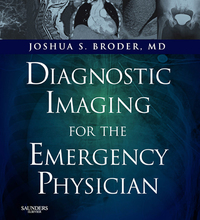「重要なお知らせ:日本語書籍をご購入いただき、eLibraryをご利用の皆さまへ」
エルゼビアは、より快適にサービスをご利用いただくため、システムの重要なアップデートを実施いたします。
現在、新サイト、eBooks+への移行が進められています。
新規ユーザー登録および書籍の登録はElsevier eLibraryでは停止しております。
12月15日以降に
こちらよりご利用・ご登録ください。
Book Description
Diagnostic Imaging for the Emergency Physician , written and edited by a practicing emergency physician for emergency physicians, takes a step-by-step approach to the selection and interpretation of commonly ordered diagnostic imaging tests. Dr. Joshua Broder presents validated clinical decision rules, describes time-efficient approaches for the emergency physician to identify critical radiographic findings that impact clinical management and discusses hot topics such as radiation risks, oral and IV contrast in abdominal CT, MRI versus CT for occult hip injury, and more. Diagnostic Imaging for the Emergency Physician has been awarded a 2011 PROSE Award for Excellence for the best new publication in Clinical Medicine.
- Consult this title on your favorite e-reader, conduct rapid searches, and adjust font sizes for optimal readability.
- Choose the best test for each indication through clear explanations of the "how" and "why" behind emergency imaging.
- Interpret head, spine, chest, and abdominal CT images using a detailed and efficient approach to time-sensitive emergency findings.
- Stay on top of current developments in the field, including evidence-based analysis of tough controversies - such as indications for oral and IV contrast in abdominal CT and MRI versus CT for occult hip injury; high-risk pathology that can be missed by routine diagnostic imaging - including subarachnoid hemorrhage, bowel injury, mesenteric ischemia, and scaphoid fractures; radiation risks of diagnostic imaging - with practical summaries balancing the need for emergency diagnosis against long-terms risks; and more.
- Optimize diagnosis through evidence-based guidelines that assist you in discussions with radiologists, coverage of the limits of "negative" or "normal" imaging studies for safe discharge, indications for contrast, and validated clinical decision rules that allow reduced use of diagnostic imaging.
- Clearly recognize findings and anatomy on radiographs for all major diagnostic modalities used in emergency medicine from more than 1000 images.
- Find information quickly and easily with streamlined content specific to emergency medicine written and edited by an emergency physician and organized by body system.


 (0 rating)
(0 rating) 




